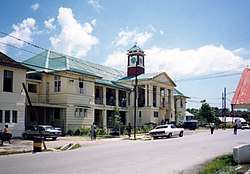Savanna-la-Mar
Savanna-la-Mar (commonly known as Sav-la-Mar, or simply Sav) is the chief town and capital of Westmoreland Parish, Jamaica. A coastal town, it contains an 18th-century fort constructed for colonial defence against pirates in the Caribbean.
Savanna-la-Mar | |
|---|---|
Parish Capital | |
 Westmoreland Parish court house | |
| Nickname(s): Sav-la-Mar | |
| Country | Jamaica |
| Parish | Westmoreland |
| Population | |
| • Estimate (2011) | 22 600 |
| Time zone | UTC-5 (EST) |
.jpg)

History
Savanna-la-Mar was originally established as a settlement in Spanish Jamaica.[1]
In 1780, the town was completely destroyed by a powerful hurricane known as Savanna-la-Mar hurricane.[2] It was rebuilt, as the port was an important part of the Atlantic trade in sugar, slaves and other goods.
After Great Britain abolished slavery in 1833 and before the abolition of slavery in the United States in 1865, its officials in the Caribbean colonies at times ordered the examination of slaves on American ships that happened to come to its Caribbean ports, to see if they wanted to stay in the colony and gain freedom, or return with the ship to the United States and slavery. In the cases of the Enterprise at Bermuda in 1835 and the Creole at Nassau in 1841–1842, a total of more than 200 slaves gained freedom.
In at least one case, residents intervened to help others gain freedom. On 20 July 1855, Jamaicans boarded the United States brig Young America, which had put into Savann-la-Mar. They had learned that the cook, a man named Anderson (alias Nettles), was a fugitive slave, and took him to shore, where he gained freedom. (He had boarded the ship with free papers in the name of Nettles.) The Jamaican magistrates did not interfere. The United States consul, R. Monroe Harrison (1768–1858), complained to the British colonial government about the incident.[3] He also published a letter in The New York Times a few days later warning shipmasters against having blacks as part of their crew on ships putting into Jamaica, at the risk of losing them.[4]
Notable people
- C.B. Bucknor – Major League Baseball umpire
- Ronnie Davis – singer, songwriter, performer
- Des Drummond – Rugby League player
- John Drummond (1744–1804) – surgeon and plantation owner
- John Dunkley – painter
- Asani Samuels – Professional footballer
- Laken Tomlinson – American football player
References
- C.V. Black, A History of Jamaica (London: Collins, 1975), p. 38.
- Ludlum, David M. (1963). Early American Hurricanes, 1492–1870. Boston: American Meteorological Society. pp. 68–69.
- "Liberation of the American Slave at Savanna la Mar," New York Times, 20 July 1855, accessed 3 April 2013
- Letter from Kingston, Jamaica by Consul R. Monroe Harrison, dated 2 July 1855, warning shipmasters against allowing blacks to crew vessels putting into Jamaica: quoted in the New York Times, 24 July 1855:
"...It is only a few days since that the brigantine Young America, Capt. ROGERS of Baltimore, arrived at Savannah-la-Mar, when the black cook or steward, being desirous of getting rid of that vessel, and the master not wishing to let him go, a band of half-savage negroes went on board and took him out by force, and insulted the captain in the most shameful manner, while the magistrates looked on and countenanced the atrocious act....You would greatly oblige me if you would be pleased to caution masters of vessels against shipping negroes to come to any port in this island, as they are sure to have trouble."
According to the Consul, the man in question had boarded the Young America with papers showing he was a free man named Nettles. Later he claimed his name was really Anderson, and he was a slave escaping from a Mr Robinson. If this proved true, the Consul said, there was no hope of retrieving him, as he would have become free "on touching British soil."
External links
